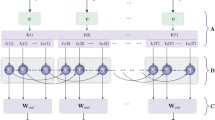Abstract
Reservoir computing is a neural network algorithm that reduces the training needed for a neural network to be function. Recently, reservoir computing has been implemented using MEMs devices with prevalent non-linear dynamics to perform non-linear processing tasks. While partially explored in the past, there has been renewed interest in using Surface Acoustic Wave devices as low energy radio-frequency processors. However they have yet to be explored in the reservoir computing framework. In this work, a 39.16 MHz two-port SAW resonator on chemically reduced YZ Lithium Niobate is design and measured. The quality factor, insertion loss, linear transmission, and non-linear transmission of the devices is measured, and the relationship of these properties to reservoir computing is discussed. The SAW resonator is then configured as a time-multiplexed reservoir, and it’s non-linear processing capabilities are discussed using the time-delayed parity benchmark.






Similar content being viewed by others
Data availability
The data generated for use in this paper is available online: https://doi.org/10.5281/zenodo.7939299.
References
Appeltant L, Soriano MC, Van der Sande G, Danckaert J, Massar S, Dambre J, Schrauwen B, Mirasso CR, Fischer I (2011) Information processing using a single dynamical node as complex system. Nat Commun 2(1):468
Appeltant L, Van der Sande G, Danckaert J, Fischer I (2014) Constructing optimized binary masks for reservoir computing with delay systems. Sci Rep 4(1):3629
Araujo FA, Riou M, Torrejon J, Tsunegi S, Querlioz D, Yakushiji K, Fukushima A, Kubota H, Yuasa S, Stiles MD, Grollier J (2020) Role of non-linear data processing on speech recognition task in the framework of reservoir computing. Sci Rep 10(1):328
Barazani B, Dion G, Morissette JF, Beaudoin L, Sylvestre J (2020) Microfabricated neuroaccelerometer: integrating sensing and reservoir computing in MEMS. J Microelectromech Syst 29(3):338–347
Brunner D, Penkovsky B, Marquez BA, Jacquot M, Fischer I, Larger L (2018) Tutorial: Photonic neural networks in delay systems. J Appl Phys 124(15):152004
Colin Campbell. 2012 Surface Acoustic Wave Devices and Their Signal Processing Applications.
Carroll TL (2020) Do reservoir computers work best at the edge of chaos? Chaos Interdiscip 30(12):121109
Dion G, Mejaouri S, Sylvestre J (2018) Reservoir computing with a single delay-coupled non-linear mechanical oscillator. J Appl Phys 124(15):152132
Duport F, Schneider B, Smerieri A, Haelterman M, Massar S (2012) All-optical reservoir computing. Opt Express 20(20):22783
Duport F, Smerieri A, Akrout A, Haelterman M, Massar S (2016) Fully analogue photonic reservoir computer. Sci Rep 6(1):22381
Hackett L, Miller M, Brimigion F, Dominguez D, Peake G, Tauke-Pedretti A, Arterburn S, Friedmann TA, Eichenfield M (2021) Towards single-chip radiofrequency signal processing via acoustoelectric electron–phonon interactions. Nat Commun 12(1):2769
Hou Y, Xia G, Yang W, Wang D, Jayaprasath E, Jiang Z, ChunXia H, ZhengMao W (2018) Prediction performance of reservoir computing system based on a semiconductor laser subject to double optical feedback and optical injection. Opt Express 26(8):10211–10219
Jaeger H (2004) Harnessing nonlinearity: predicting chaotic systems and saving energy in wireless communication. Science 304(5667):78–80
Larger L, Soriano MC, Brunner D, Appeltant L, Gutierrez JM, Pesquera L, Mirasso CR, Fischer I (2012) Photonic information processing beyond turing: an optoelectronic implementation of reservoir computing. Opt Express 20(3):3241–3249
Luukkala M, Kino GS (1971) Convolution and time inversion using parametric interactions of acoustic surface waves. Appl Phys Lett 18(9):393–394
MacKay DJC, Mac Kay DJC (2003) Information Theory, Inference and Learning Algorithms. Cambridge University Press
Paquot Y, Duport F, Smerieri A, Dambre J, Schrauwen B, Haelterman M, Massar S (2012) Optoelectronic reservoir computing. Sci Rep 2(1):287
Robbins WP (1975) Pump requirements for parametric amplification and generation of surface waves on YZ LiNbO3. IEEE Trans Son Ultrason 22(4):257–263
Schneider JD, Ting L, Tiwari S, Zou X, Mal A, Candler RN, Wang YE, Carman GP (2020) Frequency conversion through nonlinear mixing in acoustic waves. J Appl Phys 128(6):064105
Schu¨rmann F, Karlheinz M, and Schemmel J. Edge of Chaos Computation in Mixed-Mode VLSI - A Hard Liquid. In Advances in Neural Information Processing Systems, volume 17. MIT Press, 2004
Soriano MC, Ortín S, Brunner D, Larger L, Mirasso CR, Fischer I, Pesquera L (2013) Optoelectronic reservoir computing: tackling noiseinduced performance degradation. Opt Express 21(1):12–20
Strogatz SH (2019) Nonlinear dynamics and chaos: with applications to physics, biology, chemistry, and engineering, 2nd edn. CRC Press, Boca Raton
Sun J, Yang W, Zheng T, Xiong X, Liu Y, Wang Z, Li Z, Zou X (2021) Novel nondelay-based reservoir computing with a single micromechanical nonlinear resonator for highefficiency information processing. Microsyst Nanoeng 7(1):1–11
Tanaka G, Nakane R, Yamane T, Takeda S, Nakano D, Nakagawa S, Hirose A (2017) Waveform classification by memristive reservoir computing. In: Liu D, Xie S, Li Y, Zhao D, El-Alfy E-S (eds) Neural information processing. Springer International Publishing, Cham, pp 457–465
Acknowledgements
This work is supported by the Japan Society for the Promotion of Science (JSPS) Grants-in-Aid for Scientific Research JSPS KAK-ENHI Grant Number 21F20799 and 22K18289, Tateisi Science and Technology Foundation, and the Telecommunications Advancement Foundation. We also acknowledge technical support from Kyoto University Nanotechnology Hub in the “ARIM Project” sponsored by MEXT, Japan (JPMXP12-22KT1250).
Author information
Authors and Affiliations
Corresponding author
Additional information
Publisher's Note
Springer Nature remains neutral with regard to jurisdictional claims in published maps and institutional affiliations.
Rights and permissions
Springer Nature or its licensor (e.g. a society or other partner) holds exclusive rights to this article under a publishing agreement with the author(s) or other rightsholder(s); author self-archiving of the accepted manuscript version of this article is solely governed by the terms of such publishing agreement and applicable law.
About this article
Cite this article
Meffan, C., Ijima, T., Banerjee, A. et al. Non-linear processing with a surface acoustic wave reservoir computer. Microsyst Technol 29, 1197–1206 (2023). https://doi.org/10.1007/s00542-023-05463-4
Received:
Accepted:
Published:
Issue Date:
DOI: https://doi.org/10.1007/s00542-023-05463-4




